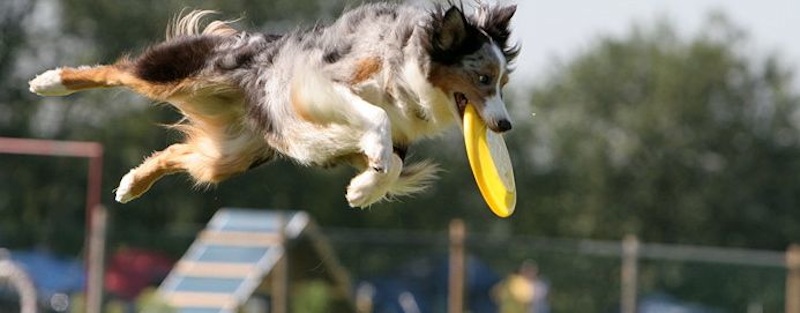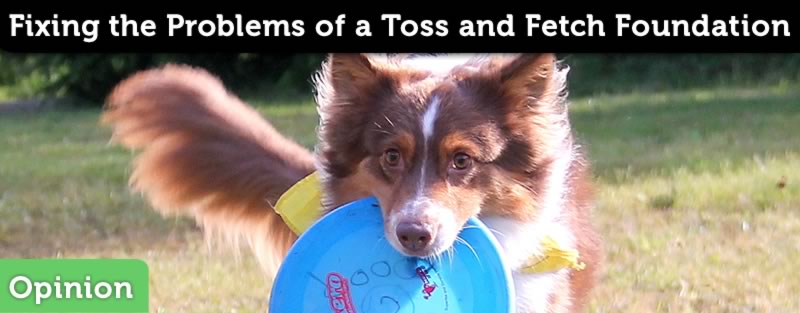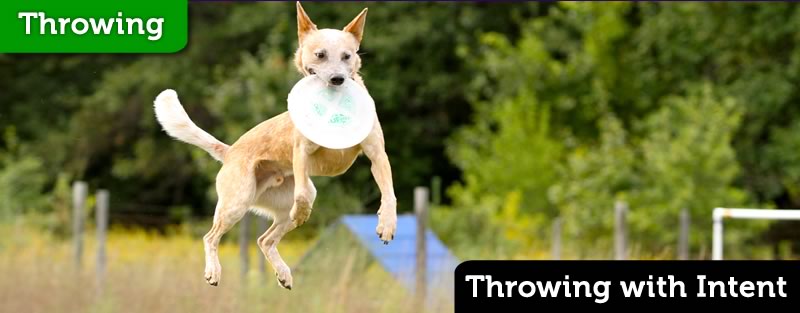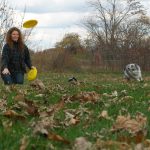
K9Disc for Agility Handlers
Originally Published in Dog Sport Magazine 2008
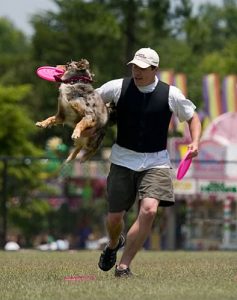
I’ve been playing disc with my dogs for over 10 years now, and in those 10 years I’ve learned a lot about competing with dogs.
Mental burnout, the dangers of repetitive stress, overtraining, the stress involved in being a highly competitive team; these things should sound familiar to many of you who have been around for a while in agility. Hopefully, you were able to learn these lessons through quality instruction and not experience, but we know this is not always the case.
Like all good dog trainers, I have many regrets. I cherish these regrets though, as they have shaped my understanding of dogs and competitive dog sports. I’m a better trainer and a far better instructor for having experienced these things first hand.
I’ve spent the last 5 years working to educate the discdog community and have been quite successful at getting information out to people so they can play better, have more fun, avoid the mistakes that I’ve made and have happy and healthy relationships with their dogs.
I’d like to help agility competitors understand more about canine disc and to clear up some of the misconceptions about the game that I know and love. I’m very excited to have this opportunity to share information that might just change the way disc sport is perceived by agility handlers and to help those who play a bit of disc with their dogs to do so safely.
Science vs Performance Art
Agility has developed into a far more scientific sport than canine disc, and it makes sense when you think about it.
Agility is an objective game. Hundredths of a second can drop you out of contention. Contacts are black and white. Precise body language and timing are required to run fast and clean. It’s quite mechanical, but when done well, it’s beautiful.
Frisbee on the other hand is a very subjective game, at least it is if we’re talking about freestyle disc, which is what I think playing disc with your dog is all about. There’s showmanship, creativity, degree of difficulty, and style. So while mechanics are important in the game of disc, it’s more of an art form.
Science versus Art. Objective results versus subjective interpretation. I have no idea why there’s a disconnect between the two communities?
Dog Training in Disc
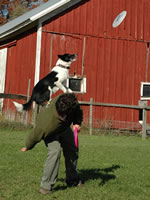
When I started playing disc with my first dog, Kimo, I didn’t put too much stock in dog training. I didn’t need to train my dog to catch discs, he just did it. I didn’t think too much of agility either.
It’s just tunnels and obstacles, big deal. Mo can do that.
Thoughts like these used to be the norm for discdoggers. I think this happens because, most of the time it is the dog that drags the handler into the game of disc. We break out a piece of plastic and our dog goes nuts. I got serious about the game because Kimo was a natural, we had to play. That’s how most discdoggers are introduced to the game.
It wasn’t until Kimo started to shut down at about 4 years old due to performance pressure that I was putting on him that I started to see the value of dog training. Shortly after I filmed and edited a Barb DeMascio seminar and saw the value of agility.
I was shocked at how precise things were. Shocked at how such tiny alterations of position and timing could shed seconds off of a run. I learned about front and rear crosses, about communicating with the shoulders. It really was more than just running through tunnels and over obstacles.
I realized it was a technical marvel. It was amazing. After filming that seminar I realized I should get a little more scientific and get a better handle on dog training. One of the things that I found so interesting about body language was that, in canine disc, we violate these principles all the time. We are constantly saying one thing with our bodies and doing something completely different.
For instance, when I set up to throw a disc, I send my dog left with my shoulders then throw it over to the right. Even though these positional principles are not always in effect in the game of disc, understanding them has made me a better disc dog handler.
Even though cookies with a high rate of reinforcement and perfect reward placement don’t happen in a freestyle routine, their presence is felt and their effectveness unmistakeable.
It’s Easy, Right?
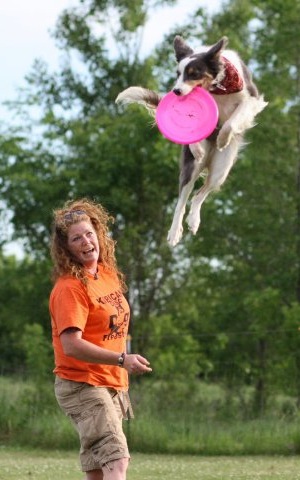
I think that the very first misconception that Agility people have about Frisbee is that it’s easy. I mean, they’re just chasing discs, just chasing the reward, right?
Well let’s look at what’s really going on: attention, outrun, tracking, chase, catch, retrieve, drop on command, positional awareness, timing, disc placement. All of these skills come into play on every throw. And that is just in a backyard game of catch.
In freestyle disc, there are literally hundreds of complex situations like these going on within the game.
Discs are moving and unstable. The dog is constantly asked to catch and release his target which doubles as the reward. There are somewhere between 5-10 rewards on the field at all times. This does not even take into account the ability of the handler to deliver a disc to the right spot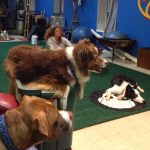 Spot is a “go to a place”, or “go to a mat” behavior. This means that the dog seeks out and performs a duration behavior on a spot of the handler’s choosing. A... More, at the right time, every time, to make the game safe and visually appealing.
Spot is a “go to a place”, or “go to a mat” behavior. This means that the dog seeks out and performs a duration behavior on a spot of the handler’s choosing. A... More, at the right time, every time, to make the game safe and visually appealing.
When agility competitors see quality Frisbee in person, with good responsible handlers, they are impressed. The high level of teamwork and communication and the complexity of the game are obvious.
Just like agility is more than running through tunnels and over obstacles, Frisbee is more than just chasing and catching discs.
Freestyle disc with a dog, Jamming, is not easy and it’s not simple. It’s an art form.
It’s Dangerous, Right?
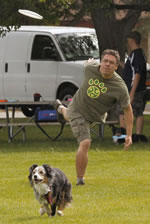
Another misconception that agility handlers have about Frisbee is that it’s dangerous.
Like all dog sports, the game is as safe as the handler makes it. Responsible handling is the key to safety in all Dog Sports, and responsible handling in Frisbee is not much different from responsible handling in agility.
Our dogs must be in good condition which means that discdog handlers must ensure that their dogs are getting quality nutrition and are not overweight.
Our dogs must understand and be able to perform the requirements of our game which means they must be trained: position, timing and rear end awareness are extremely important to the game of Frisbee. Responsible handlers spend time on these key areas.
Discdog handlers must be aware of our dogs limitations and develop our game accordingly. We must learn to read our dogs and develop a playing style that takes into account our dog’s strengths and weaknesses. Structure, the dog’s sense of self preservation, age and physical capabilities all must be taken into account to create a game that is safe and fun for our dog.
Another thing that is extremely important for safety on the handler end is the ability to deliver a disc to a particular spot at a particular time. This is something that is often overlooked by agility competitors and discdoggers alike.
The same kind of consistency that is required in teaching our dogs basic obedience, foundational jumpwork, contacts, and any other behaviors is required in our disc placement.
Consistent disc placement can actually teach our dogs to leap and to leap correctly. Inconsistent disc placement can teach our dog either to flail about or to not jump at all. Of course, there are dogs out there that look good regardless of where the disc is placed, but that is the exception, not the rule. The ability to place a disc in a good spot at the right time is probably the most important thing a handler can do to make sure the game of disc is played safely.
Jumping Like that Can’t be Safe
Leaping in agility is obstacle based, and has been heavily influenced by centuries of understanding taken from the leaping of racing horses.
Agility dogs leap on the run, the faster the better. A leap should not sacrifice speed:
Collection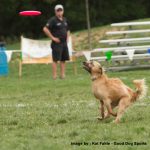 The act of preparing for a leap. Breaking stride for leaping or changing direction, collection is a key moment in the leaping process. More takes place at speed and is to be efficient.
The act of preparing for a leap. Breaking stride for leaping or changing direction, collection is a key moment in the leaping process. More takes place at speed and is to be efficient.
Trajectory is to be just high enough to clear the obstacle.
Landing is to be clean and efficient with as little speed lost as possible.
This concept of jumping is very different from the target based jumping of Discdogs.
Discdogs leap for targets.
Speed is totally variable.
Collection is dramatic and slow.
Trajectory is based upon the placement of the target.
Landings are to be clean and efficient, but have nothing to do with speed.
Because the game of Disc is not dependent upon speed and is entirely dependent upon a target, there are entirely different leaping concepts in play. Comparing agility leaping to leaping for discs is like comparing track and field to Gymnastics. Both of these sports have an their own specialized technique and their own rules about safety. Very little is valid in both sports.
Viewing the safety of Gymnastics through the lens of a Track coach does not adequately represent the safety of Gymnastics, just as looking at the safety of Frisbee through the lens of an Agility handler does not adequately represent the safety of Frisbee.
Wrapping things up
Dog sports are as safe as the handler makes them. We must all be aware of our dog’s abilities and limitations and of our own and should do our best to structure play with these factors in mind.
Handler’s are responsible for seeking out quality information, evaluating it honestly and putting it into practice as best we can and training outside of your game of choice whether it be socialization, obedience, another dog sport is good for you and your dog as a team.
None of the dog sports are easy, otherwise we’d all be doing them. None of them are seriously dangerous or nobody would be playing them. All dog sports share common, but diverse foundations that could and should be shared within the dog sport community.





